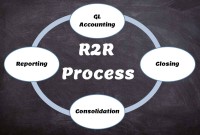- Home
- Business Processes
- Industry Knowledge
- Aerospace Industry
- Automotive Industry
- Banking Domain
- BFSI Industry
- Consumer/ FMCG Industry
- Chemicals Industry
- Engineering & Construction
- Energy Industry
- Education Domain
- Finance Domain
- Hospitality Domain
- Healthcare Industry
- Insurance Domain
- Retail Industry
- Travel and Tourism Domain
- Telecom Industry
- Leadership Skills
- eLearning
- Home
- Business Processes
- General Ledger (Record to Report)
- Legal Structures for Multinational Companies
Legal Structures for Multinational Companies
A multinational company generally has offices and/or factories in different countries and a centralized head office where they coordinate global management. A multinational company (MNC)is a corporate organization that owns or controls the production of goods or services in at least one country other than its home country.
Due to advent of information age and globalization, the traditional hierarchy of the industrial age is rapidly disappearing and new large groups that are spread across the globe are fast emerging. A multinational corporation is a company with headquarters in one country but they operate in many countries. The post Second World War period saw the rapid growth of multinationals in Europe, America and Japan. As the world economy is opening up with a fall in regulatory barriers to foreign investment, better transport and communications, freer capital movements, etc., international companies are finding it easier to invest where they choose to cheaply, and with less risk. With the advent of globalization, companies started expanding to international markets and establishing marketing, manufacturing, or research and development facilities in several foreign countries.
What are multi-national companies?
A multinational company generally has offices and/or factories in different countries and a centralized head office where they coordinate global management. A multinational company (MNC)is a corporate organization that owns or controls the production of goods or services in at least one country other than its home country. One of the first multinational business organizations, the East India Company, was established in 1601. After the East India Company, came the Dutch East India Company in 1603, which would become the largest company in the world for nearly 200 years.
Some current examples are big multi national companies like Apple, Google, Amazon, Coca-Cola, Starbucks, IBM, FedEx, Accenture, Samsung or General Electric etc. Nestle and Shell Oil are two examples of European multinational. Most of the largest and most influential companies of the modern age are publicly traded multinational corporations, including Forbes Global 2000 companies.
What are Conglomerates?
A conglomerate is a combination of two or more corporations engaged in entirely different businesses that fall under one corporate group, usually involving a parent company and many subsidiaries. Often, a conglomerate is a multi-industry company. Conglomerates are often large and multinational.
Features of MNCs & Conglomerates
Some of the attributes associated with these large multi-national corporations are:
- These multinational groups operate across the boundaries of nations
- They employ and serve thousands of people with different cultures.
- Their annual sales turnover is in billions of dollars.
- They raise money in different stock markets.
- In spite of all these diversities they may be part of the same global group.
- These companies operate as individual entities in different countries/markets and consolidate with the group.
- Domestic corporations are taxed on their worldwide income at the federal (country) and state levels.
- Compliance (without overpaying) makes the products & services of these conglomerates more competitive, earnings more attractive to investors & company a more responsible corporate citizen.
Evolution of Legal Structures for MNCs/Conglomerates
They are dynamic organizations that are constantly changing and evolving, acquiring and merging many companies, opening their offices in all parts of world and operating under the ambit of ever-changing complex organizational structures.
Fundamentally a corporation must be legally domiciled in a particular country and engage in other countries through foreign direct investment and the creation of foreign branches or foreign subsidiaries.
All these large groups have smaller companies within them. The conglomerate may be constituted of different units which may represent separate legal entities constituted in different countries having multiple layers of ownership (which might be added to the group through mergers, acquisitions or could be joint ventures). Multinational corporations can select from a variety of jurisdictions for various subsidiaries, but the ultimate parent company can select a single legal domicile.
Global operations of these corporations are conducted with multiple subsidiaries, branch offices and joint venture partners working together, constantly evolving and changing their legal structures through mergers, acquisitions and takeovers. These subsidiaries and partners are responsible for their own P&L. They have their own Fixed Assets (such as assets held for the purpose of producing or providing goods/services) and their own markets where their own or their other group concern’s products are sold and eventually consolidate with the group.
Multinational corporations may be subject to the laws and regulations of both their domicile and the additional jurisdictions where they are engaged in business. In some cases, the jurisdiction can help to avoid burdensome laws. Corporations can legally engage in tax avoidance through their choice of jurisdiction, but must be careful to avoid illegal tax evasion. These MNCs should comply fully with all statutory and tax laws & regulations around the world and ensure payment of the correct amount of taxes in every country where it operates.
Aside from setting up a private limited company as subsidiary, foreign companies have two other options for entering the foreign market – a Branch Office or a Representative Office. Both are registered locally in the country of operations, follow local procedures, and need to pay official fees for registration.
Related Links
You May Also Like
-
McKinsey 7S Framework is most often used as an organizational analysis tool to assess and monitor changes in the internal situation of an organization. The model is based on the theory that, for an organization to perform well, seven elements need to be aligned and mutually reinforcing.
-
GL - Different Type of Journals
Two basic types of journals exist: general and special. In this article, the learner will understand the meaning of journalizing and the steps required to create a journal entry. This article will also discuss the types of journals and will help you understand general journals & special journals. In the end, we will explain the impact of automated ERPs on the Journalizing Process.
-
Period End Accruals, Receipt Accruals, Paid Time-Off Accruals, AP Accruals, Revenue Based Cost Accruals, Perpetual Accruals, Inventory Accruals, Accruals Write Off, PO Receipt Accrual, Cost Accrual, etc. are some of the most complex and generally misconstrued terms in the context of general ledger accounting. In this article, we will explore what is the concept of accrual and how it impacts general ledger accounting.
-
Shared Services is the centralization of service offering at one part of an organization or group sharing funding and resourcing. The providing department effectively becomes an internal service provider. The key is the idea of 'sharing' within an organization or group.
-
Legal Structures in Businesses
Businesses not only vary in size and industry but also in their ownership. Most businesses evolve from being owned by just one person to a small group of people and eventually being managed by a large numbers of shareholders. Different ownership structures overlap with different legal forms that a business can take. A business’s legal and ownership structure determines many of its legal responsibilities.
-
GL - Accrued / Unbilled Revenue
Accrued revenues (also called accrued assets) are revenues already earned but not yet paid by the customer or posted to the general ledger. Understand what we mean by the terms accrued revenue, accrued assets, and unbilled revenue. Explore the business conditions that require recognition of accrued revenue in the books of accounts and some industries where this practice is prevalent.
-
In this article, we will explain the general Ledger journal processing flow from entering journals to running the final financial reports. Understand the generic general ledger process flow as it happens in automated ERP systems. The accounting cycle explains the flow of converting raw accounting data to financial information whereas general ledger process flow explains how journals flow in the system.
-
Divisional Organizational Structures
The divisional structure or product structure consists of self-contained divisions. A division is a collection of functions which produce a product. It also utilizes a plan to compete and operate as a separate business or profit center. Divisional structure is based on external or internal parameters like product /customer segment/ geographical location etc.
-
Global Business Services (GBS) Model
Global business services (GBS) is an integrated, scalable, and mature version of the shared services model. Global Business Services Model is a result of shared services maturing and evolving on a global scale. It is represented by the growth and maturity of the Shared services to better service the global corporations they support.
-
Record to report (R2R) is a finance and accounting management process that involves collecting, processing, analyzing, validating, organizing, and finally reporting accurate financial data. R2R process provides strategic, financial, and operational feedback on the performance of the organization to inform management and external stakeholders. R2R process also covers the steps involved in preparing and reporting on the overall accounts.
Explore Our Free Training Articles or
Sign Up to Start With Our eLearning Courses

About Us
Learning
© 2023 TechnoFunc, All Rights Reserved











